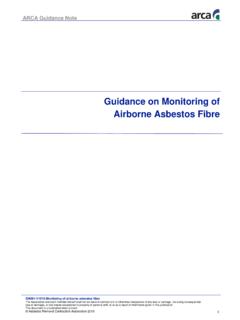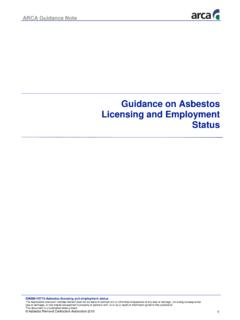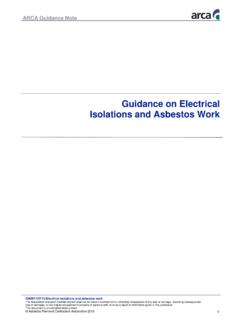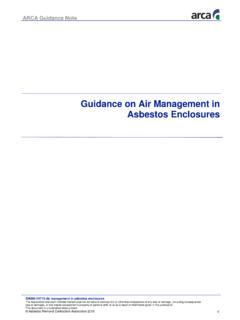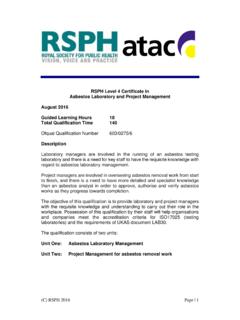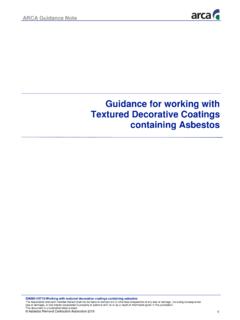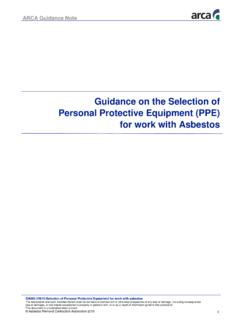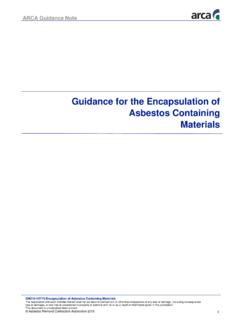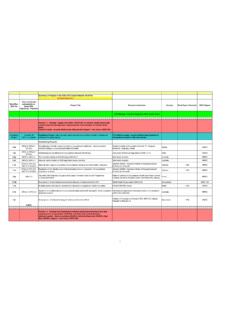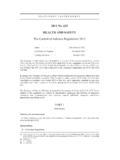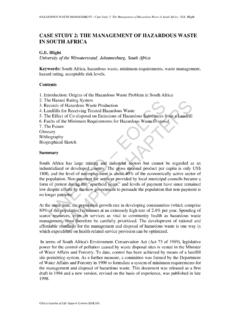Transcription of Guidance for Personal Air Monitoring - Asbestos
1 1 GN013-V0316- Personal Air Monitoring The Association and each member thereof shall not be liable in contract tort or otherwise irrespective of any loss or damage, (including consequential loss or damage), or any nature occasioned to property or persons with, to or as a result of information given in this publication. This document is uncontrolled when printed. Asbestos Removal Contractors Association 2016 ARCA Guidance Note Guidance for Personal Air Monitoring 2 GN013-V0316- Personal Air Monitoring The Association and each member thereof shall not be liable in contract tort or otherwise irrespective of any loss or damage, (including consequential loss or damage), or any nature occasioned to property or persons with, to or as a result of information given in this publication. This document is uncontrolled when printed. Asbestos Removal Contractors Association 2016 ARCA Guidance Note Guidance FOR Personal AIR Monitoring 1.
2 BACKGROUND ARCA is aware of concerns raised about the way Personal air Monitoring is routinely being carried out in the Asbestos industry. Licence holders are advised to review Why they are collecting Personal Monitoring data How data is being collected and What is being done with the data. Personal Monitoring can be carried out for a variety of purposes. Many licensed contractors may be gathering data in a way that cannot be used to compare exposures with other jobs and cannot demonstrate meaningful Personal exposure data. Licence holders also may be using sampling strategies that do not reflect a representative sample of their work and therefore cannot demonstrate effective performance. Where this is the case, licence holders may be wasting significant time and money on sampling that adds little benefit or reassurance. This could also be seen as a wider failure of health and safety management when licence assessments are carried out. 2.
3 KEY POINTS Planning work Personal Monitoring requirements must be considered when planning a job. The contractor should give the analyst clear instructions about the purpose of the sampling. Sufficient sampling duration Sampling should be carried out for sufficient durations: shift duration (preferably 2-4 hour periods) or the duration of specific tasks being observed. Use the correct flow rate 4-hour TWA When considering Personal exposure, results should be reported as a 4-hour, time weighted average. Record the activity Sampling records need to clearly describe the activities being undertaken and the control measures in place at the time of Monitoring ( AIB removal is not enough detail). Sampling strategies Strategies for organising sampling need to capture a representative sample of work ( 50% of AIB work is unlikely to be precise enough). Use the data When measuring site performance When assessing future work As a record of Personal exposure 3 GN013-V0316- Personal Air Monitoring The Association and each member thereof shall not be liable in contract tort or otherwise irrespective of any loss or damage, (including consequential loss or damage), or any nature occasioned to property or persons with, to or as a result of information given in this publication.
4 This document is uncontrolled when printed. Asbestos Removal Contractors Association 2016 ARCA Guidance Note 3. LEGAL REQUIREMENTS The Control of Asbestos Regulations 2012 (CAR) contain numerous references to the requirement for Personal and background Monitoring . Regulation 19 requires employers to arrange regular Monitoring of airborne fibres and keep records of the results. Assessments of any proposed work must consider the results of this Monitoring (regulation 6). The significant findings of Asbestos assessments should be reflected in the plan of work (required by regulation 7). An organisation s arrangements for providing information, instruction and training must include detail of any air Monitoring results (regulation 10). Employers must ensure that Personal exposure to Asbestos is prevented, so far as is reasonably practicable (regulation 11). Licensed work, by definition, is likely to produce airborne concentrations that exceed the control limit: where exposure cannot be prevented, it must be kept as low as reasonably practicable.
5 Respiratory Protective Equipment (RPE) provided must ensure that concentration of Asbestos fibres within the respirator is kept below the control limit. The spread of Asbestos must be prevented or reduced (regulation 16). Exposure records form part of the health records that must be kept for any employees engaged in licensed Asbestos work (regulation 22). Regulation 5 of the Management of Health and Safety at Work Regulations require employers to have effective arrangements in place for managing health and safety. Personal Monitoring records should be an excellent indicator of performance and an aid to comparing and assessing removal situations. To achieve this, sampling must be planned and recorded in a meaningful way. 4. PURPOSE OF Personal AIR Monitoring Personal air Monitoring can provide invaluable performance information: it should provide an accurate record of actual concentrations of airborne fibre generated by particular types of work in particular circumstances, and give licence holders confidence (and clients, regulators etc) that control methods are working, in practice.
6 In summary, CAR, the Approved Code of Practice and existing Guidance give the following reasons for carrying out Personal air Monitoring : To check the effectiveness of the controlled method or removal ( by comparison to previous concentrations of airborne fibre in similar situations and to the control limit. To provide data for Personal exposure records. To guide assessment (and planning) for future, similar jobs. To confirm that appropriate RPE has been chosen. 4 GN013-V0316- Personal Air Monitoring The Association and each member thereof shall not be liable in contract tort or otherwise irrespective of any loss or damage, (including consequential loss or damage), or any nature occasioned to property or persons with, to or as a result of information given in this publication. This document is uncontrolled when printed. Asbestos Removal Contractors Association 2016 ARCA Guidance Note 5. SAMPLING: PLANNING AND ENGAGING WITH THE ANALYST Decisions about the type(s) of Monitoring to be done (and detail about how this will be carried out) should be considered at the planning stage.)
7 This will be reflected in the plan of work produced prior to notification and supported by standard procedures etc. Effective Monitoring will require good liaison and engagement between the licence holder and the analyst. The service agreement between the two organisations should make expectations clear (and take into account the issues described in this document). For example, if an analyst is expected to observe work activities during the sampling period, this may limit capacity for carrying out other types of air Monitoring at the same time. 6. SAMPLING METHODS Sampling duration and flow rates So that sampling results can be compared between jobs, a standardised approach for gathering and recording is required. This should be specified in standard procedures and / or contractual arrangements with an appointed analyst. The control limit refers to a time weighted average (TWA) of fibres/cm3 of air averaged over a continuous period of 4 hours.
8 Monitoring may also be carried out to assess fibre concentrations associated with particular short duration activities ( sporadic and low intensity (SALI)), with reference to a 10 minute sampling period. Where the purpose is comparison with the control limit or gathering Personal exposure data, HSE will expect sampling periods to be as close to 4-hour periods as is reasonably practicable; the results should be recorded as a 4-hour TWA. Analysts might use a succession of sampling periods, or a single shorter period that is representative of the work, but where this is the case licence holders should expect a clear explanation of the assumptions being made to report results as a 4-hour TWA. When considering exposures in relation to the 4-hour control limit, sampling rates should be 1 litre/minute. When taking shorter samples, for example in relation to sporadic and low intensity assessments and exposures, sampling rates should be 4 litres/minute. Activity In the past, contractors have typically recorded the broad category of work being undertaken at the time of Personal air sampling.
9 For example, the sampling records may state AIB removal . This is not precise enough to allow for meaningful comparison between jobs. For example: the previous sampling might have involved a simple clean activity of lifting boards from grid; this can t be compared against the removal of glued or nailed AIB. Relevant detail of the work activities should be addressed in a suitable and sufficient plan of work and might include: The scale of the work (1 small panel or 100m of panels?) The type of fixings (screwed, nailed, glued, the presence of voids above AIB?) Method of removal (Surfactant applied from above? Panels unscrewed whilst using shadow vacuum? Bagged or wrapped? etc.) 5 GN013-V0316- Personal Air Monitoring The Association and each member thereof shall not be liable in contract tort or otherwise irrespective of any loss or damage, (including consequential loss or damage), or any nature occasioned to property or persons with, to or as a result of information given in this publication.
10 This document is uncontrolled when printed. Asbestos Removal Contractors Association 2016 ARCA Guidance Note The condition of the tiles, surface treatments and ease of access etc. In addition, the analyst should also be able to give an opinion on the activity. Having observed the activity during the sampling period, did the control measures appear to be working effectively? Were there any difficulties observed? This level of detail about the actual activities being undertaken during the sampling period will be crucial for gathering meaningful sampling data. It is therefore important that the removal contractor gives clear instructions to the analyst: to provide meaningful data, analysts will be expected to observe what activities are taking place during the sampling period. Records For useful comparisons, exposures should be recorded as TWA, unless the focus is on specific short-duration tasks. See the appendix for a suggested Personal sampling template.
